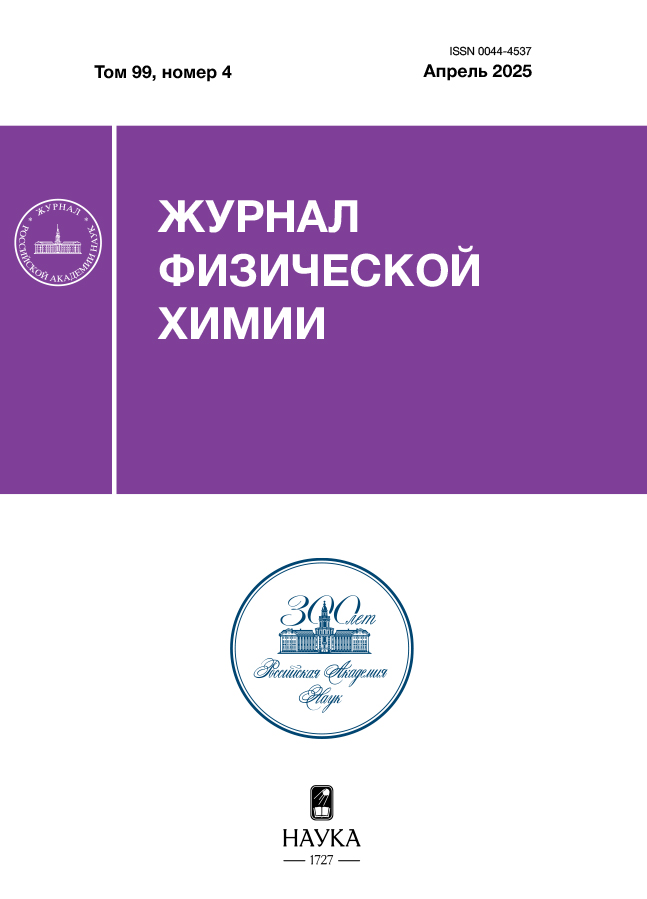Adsorption of molybdenum(VI) and rhenium(VII) on mechanically activated graphite
- Авторлар: Korobitsyna A.D.1, Pechishcheva N.V.1, Konysheva E.Y.1, Shunyaev K.Y.1
-
Мекемелер:
- Institute of Metallurgy, Ural Branch of the Russian Academy of Sciences
- Шығарылым: Том 99, № 4 (2025)
- Беттер: 636-647
- Бөлім: PHYSICAL CHEMISTRY OF DISPERSED SYSTEMS AND SURFACE PHENOMENA
- ##submission.dateSubmitted##: 14.06.2025
- ##submission.dateAccepted##: 14.06.2025
- ##submission.datePublished##: 15.06.2025
- URL: https://cardiosomatics.ru/0044-4537/article/view/684408
- DOI: https://doi.org/10.31857/S0044453725040123
- EDN: https://elibrary.ru/FPLETU
- ID: 684408
Дәйексөз келтіру
Аннотация
Sorption properties of mechanically activated graphite towards molybdenum and rhenium are studied for the first time. The optimal conditions are found such that the metals can be separated, and adsorption of molybdenum up to 95 % with adsorption of rhenium 3 % is achieved: nitric acid solution, pH 3 in the presence of 50 vol.% ethanol, stirring for 60 min. The maximum sorption capacity of the sorbent towards Mo(VI) according to the Langmuir model is 115 mg/g. The adsorption followed a pseudo-second order kinetics model. The sample after molybdenum adsorption is characterized by X-ray photoemission spectroscopy, X-ray diffraction, and X-ray-structural analysis, and scanning electron microscopy. The mechanical activation resulted in a decrease in the average size of graphite crystallites, an increase in the distance between layers, and a change in the surface state of carbon.
Негізгі сөздер
Толық мәтін
Авторлар туралы
A. Korobitsyna
Institute of Metallurgy, Ural Branch of the Russian Academy of Sciences
Хат алмасуға жауапты Автор.
Email: annakorobitsyna@mail.ru
ORCID iD: 0000-0002-7830-2274
Ресей, Ekaterinburg, 620016
N. Pechishcheva
Institute of Metallurgy, Ural Branch of the Russian Academy of Sciences
Email: annakorobitsyna@mail.ru
ORCID iD: 0000-0002-7281-1342
Ресей, Ekaterinburg, 620016
E. Konysheva
Institute of Metallurgy, Ural Branch of the Russian Academy of Sciences
Email: annakorobitsyna@mail.ru
ORCID iD: 0000-0003-3043-7978
Ресей, Ekaterinburg, 620016
K. Shunyaev
Institute of Metallurgy, Ural Branch of the Russian Academy of Sciences
Email: annakorobitsyna@mail.ru
ORCID iD: 0000-0002-1530-5988
Ресей, Ekaterinburg, 620016
Әдебиет тізімі
- Торшонов Д.Б., Гуляшинов А.Н., Антропова И.Г. // Фундаментальные исследования. 2005. № 9. С. 30.
- Петрова А.М., Касиков А.Г. // Тр. Кольского научного центра РАН. 2015. С. 190.
- Evdokimova O., Zaitceva P., Pechishcheva N. et al. // Curr. Anal. Chem. 2014. V. 10, № 4. P. 449. https://doi.org/10.2174/157341101004140701102351
- Pechishcheva N., Korobitsyna A., Ordinartsev D. et al. // Sep. Sci. Technol. 2022. V. 57. № 2. P. 180. https://doi.org/10.1080/01496395.2021.1891436
- Палант А.А., Трошкина И.Д., Чекмарев А.М., Костылев А.И. Технология рения. М.: ООО «Галлея-Принт», 2015. 329 с.
- Seo S., Choi W.S., Yang T.J. et al. // Hydrometallurgy. 2012. V. 129—130. P. 145. https://doi.org/10.1016/j.hydromet.2012.06.007
- Chen D., Chang H., Meng Q., Xing C. // Trans. Non Ferrous Met. Soc. China. 1993. V. 3. № 1. P. 35.
- Романенко А.В., Симонов П.А. Промышленный катализ в лекциях № 7. М.: Калвис, 2007. 128 с.
- Toteva V., Radoykova T., Tzvetkova Ch. et al. // Bulg. Chem. Commun. 2021. V. 53. № 3. P. 287. https://doi.org/10.34049/bcc.53.3.5333
- Хандорин Г.П., Дубов Г.И., Мазин В.И. и др. // Изв. томского политех. ун-та. 2010. Т. 316. № 3. С. 5.
- Pechishcheva N.V., Estemirova S. Kh., Kim А.V., P.V. et al. // Diamond Relat. Mater. 2022. V. 127. 109152. https://doi.org/10.1016/j.diamond.2022.109152
- Кононов В.А. // Новые огнеупоры. 2021. Т. 1. № 3. С. 3. https://doi.org/10.17073/1683-4518-2021-3-3-10
- Crystallography Open Database (COD). https://www.crystallography.net/cod/search.html. Последнее обращение 15 октября 2024.
- Hou Y., Wu J., Konysheva E. Yu. // Int. J. Hydrogen Energy. 2016. V. 41. № 6. P. 3994. https://doi.org/10.1016/j.ijhydene.2015.12.168
- Shlyakhtina A.V., Lyskov N.V., Konysheva E. Yu. et al. // J. Solid State Electrochem. 2020. V. 24, P. 1475. https://doi.org/10.1007/s10008-020-04574-6
- Toby B.H., Von Dreele R.B. // J. Appl. Crystallogr. 2013. V. 46. P. 544. https://doi.org/10.1107/S002188981300353
- Pagnanelli F., Ferella F., Michelis I.D., Vegliò F. // Hydrometallurgy. 2011. V. 110. P. 67. https://doi.org/10.1016/j.hydromet.2011.08.008
- Муханова И.М., Новикова Е.А., Минахметов Р.А. Поверхностные явления. Самара: Изд-во Самар. ун-та, 2022. 96 с.
- Ергожин Е.Е., Чалов Т.К., Хакимболатова К.Х. и др. // Актуальные проблемы гуманитарных и естественных наук. 2015. № 2—1. С. 54.
- Мельников С.С., Заболоцкий В.И., Ачох А.Р. // Сорбционные и хроматографические процессы. 2014. Т. 14. № 2. С. 312.
- Матвейчук Ю.В., Станишевский Д.В. // Журн. аналит. химии. 2020. Т. 75. № 6. С. 496. https://doi.org/10.31857/S0044450220040106
- Гольц Л.Г., Колпакова Н.А. // Изв. Томского политех. ун-та. 2006. Т. 309. № 6. С. 77.
- Kołczyk-Siedlecka K., Socha R.P., Yang X. et al. // Hydrometallurgy. 2023. V. 215. P. 105973. https://doi.org/10.1016/j.hydromet.2022.105973
- Антонов А.В., Ищенко А.А. // Изв. высших учебных заведений. Химия и химическая технология. 2007. Т. 50. № 9. С. 113.
- Филиппова И., Филиппова Н. Способ обработки смеси этилового спирта и воды (патент RU2107679 C1, 1996).
- Гайбакян Д.С., Худавердян Д.Х. // Армянский хим. журн. 1975. № 5. С. 390.
- Котельникова Т.А., Кузнецов Б.В., Морева А.А., Муравьева Г.П. // Сорбционные и хроматографические процессы. 2012. Т. 12. № 2. С. 295.
- Benzaoui T., Selatnia A., Djabali D. // Adsorpt. Sci. Technol. 2018. V. 36. № 1—2. P. 114. https://doi.org/10.1177/0263617416685099
- Fayos J. // J Solid State Chem. 1999. V. 148. № 2. P. 278. https://doi.org/10.1006/jssc.1999.8448
- Kovtun A., Jones D., Dell’Elce S. et al. // Carbon. 2019. V. 143. P. 268. https://doi.org/10.1016/j.carbon.2018.11.012
- Biesinger M.C. // Appl. Surf. Sci. 2022. V. 597. 153681. https://doi.org/10.1016/j.apsusc.2022.153681
- Ляшенко С.Е. // Успехи современного естествознания. 2017. № 1. С. 13.
- Hassan A., Haile A.S., Tzedakis T. et al. // ChemSusChem. 2021. V. 14. № 18. P. 3945. https://doi.org/10.1002/cssc.202100966
- Шеин А.Б., Габов А.Л. Физические методы исследования. Металлография, микроскопия, электронная спектроскопия. Пермь, 2023. 168 c.
- Shan W., Shu Y., Chen H. et al. // Hydrometallurgy. 2016. V. 165. P. 251. https://doi.org/10.1016/j.hydromet.2016.02.005
- Gaete J., Molina L., Alfaro I. et al. // Miner. Eng. 2019. V. 136. P. 66. https://doi.org/10.1016/j.mineng.2019.03.006
- Derakhshi P., Ghafourian H., Khosravi M., Rabani M. // World Appl. Sci. J. 2009. V. 7. № 2. P. 230.
Қосымша файлдар

















